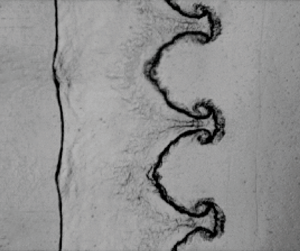Article contents
Shock-tube studies of single- and quasi-single-mode perturbation growth in Richtmyer–Meshkov flows with reshock
Published online by Cambridge University Press: 10 May 2022
Abstract

The Richtmyer–Meshkov instability of heavy/light single-mode (SM), trapezoid (TR) and sawtooth (ST) interfaces is studied experimentally by considering the reshock. The TR and ST interfaces can be expanded into Fourier series with a dominant fundamental mode and more high-order modes, recognized as quasi-single-mode ones. In experiments, the distorted interfaces at the time of first reshock arrival develop in the weakly nonlinear stage, ensuring an approximate single-scale function of evolving interface. The results show an evident memory of initial interface shapes: the bubbles and spikes of ST interface after reshock mainly develop in the streamwise direction with sharp heads, while the counterparts of TR interface tend to grow in the spanwise direction. The influences of high-order modes are amplified by the reshock, resulting in significant interface shape dependence of mixing width growths. The amplitude superposition of major odd-order modes promotes the growth rates of mixing widths for the SM and ST cases, different from the TR one. The ST interface has larger mixing width growth rates in comparison with the SM interface, since high-order modes play a great role in promoting the increase of ST amplitudes, while the TR interface has a relatively small one. The linear and nonlinear mixing width growths of SM, TR and ST interfaces before and after reshock are further analysed theoretically, indicating that the fundamental mode still has a predominant influence on the interface evolution after reshock, and the growth behaviours exhibit strong similarities to those for the singly shocked cases.
JFM classification
- Type
- JFM Papers
- Information
- Copyright
- © The Author(s), 2022. Published by Cambridge University Press
References
REFERENCES
- 15
- Cited by





